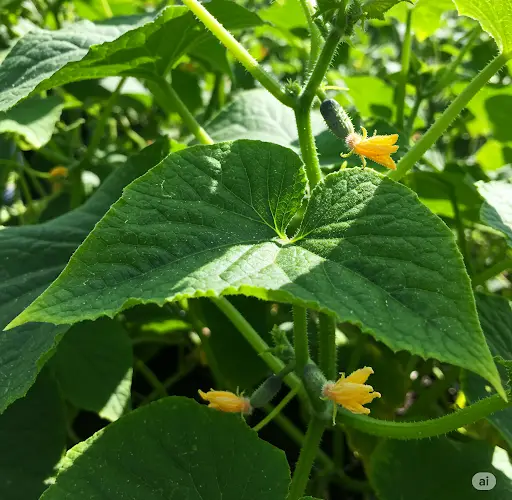Cucumbers are one of the most productive and satisfying crops to grow in a garden, but their yield depends heavily on how you start them. While many gardeners focus on watering, feeding, and trellising later in the season, the secret to a truly abundant cucumber harvest lies in what you do right at the time of planting.
By adding just a few natural ingredients into the planting hole, you can create a nutrient-rich environment that supports rapid growth, strong root development, and an extended fruiting season. This method is easy, inexpensive, and uses items you likely already have at home or can find at any garden supply shop.
Let’s take a look at what to add to the hole when planting cucumbers for a crop that will amaze you with its size and productivity.
Why Preparing the Planting Hole Matters
Cucumbers are fast-growing and hungry plants. From the moment the seeds germinate or transplants are placed in the soil, they need access to both quick-release and slow-release nutrients. A well-prepared planting hole acts as a mini-reservoir of fertility and moisture retention right where the plant needs it most — at the roots.
Ignoring this crucial first step can result in weak plants, yellowing leaves, low fruit production, and increased susceptibility to pests and disease. But with the right materials in the hole, your cucumbers will thrive from day one.
Ingredients to Add When Planting Cucumbers
1. Compost or Well-Rotted Manure (2–3 handfuls)
Compost is the foundation of soil health. It adds organic matter, improves soil structure, and provides a balanced supply of macro- and micronutrients.
-
Stimulates root growth
-
Encourages beneficial microbial activity
-
Improves water retention and drainage
Make sure it’s fully decomposed so that it doesn’t “burn” young plants.
2. Wood Ash (1 tablespoon)
Wood ash is rich in potassium and trace minerals, which are essential for flowering and fruiting. It also helps to slightly raise soil pH, which cucumbers generally appreciate.
-
Increases flowering
-
Boosts fruit development
-
Provides calcium and magnesium
Do not overuse, especially if your soil is already alkaline.
3. Eggshell Powder or Crushed Shells (1 tablespoon)
Calcium helps prevent common issues like blossom end rot and promotes strong cell walls.
-
Supports strong stems
-
Prevents fruit deformities
-
Provides a long-term source of calcium
Dry the shells, crush or grind them finely, and sprinkle in the hole.
4. Banana Peel (1 small piece or half a peel)
Banana peels are a slow-release source of potassium and phosphorus — both critical for healthy plant development and fruiting.
-
Encourages strong root systems
-
Boosts plant immunity
-
Promotes large, tasty cucumbers
Chop it into small pieces to speed up decomposition.
5. A Handful of Onion or Garlic Skins (Optional)
These are natural insect repellents and add trace minerals to the soil as they break down.
-
Keeps soil-dwelling pests at bay
-
Improves soil biology
-
Supplies sulfur compounds that can strengthen plant defenses
They’re especially useful if you’re planting in a location with a history of pest problems.
How to Plant for Maximum Results
Follow these steps when planting cucumber seedlings or seeds:
-
Dig a hole about 20 cm deep and wide (8 inches).
-
Add each of the above ingredients to the bottom of the hole.
-
Mix lightly with the soil so roots are not in direct contact with concentrated materials.
-
Fill in a bit of soil to cover the amendments.
-
Plant your seedling or seeds.
-
Water generously to activate the nutrients and settle the soil.
Space cucumber plants at least 30–40 cm (12–16 inches) apart to ensure good airflow and enough room for vines to spread or climb.
Ongoing Care for an Abundant Harvest
Once planted, continue caring for your cucumbers with these practices:
-
Mulch around the base to retain moisture and suppress weeds.
-
Water deeply and regularly, especially during flowering and fruiting.
-
Train vines vertically using a trellis to improve airflow and save space.
-
Fertilize every 2–3 weeks with a diluted compost tea or organic fertilizer high in potassium.
What to Expect
With this planting hole method, most gardeners report:
-
Faster seedling establishment
-
More blossoms earlier in the season
-
Larger, more flavorful cucumbers
-
Fewer disease problems due to stronger, more resilient plants
The best part? This method is fully organic and sustainable, meaning you can use it year after year to improve your soil health and crop productivity without relying on synthetic chemicals.
Final Thoughts
A bountiful cucumber harvest starts long before the first flowers appear. By enriching the planting hole with the right ingredients, you give your cucumbers a powerful head start — and they’ll reward you with vine after vine loaded with fruit.
This simple technique can turn even average soil into a thriving bed for cucumbers. Try it once, and you’ll be amazed at the difference.



